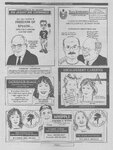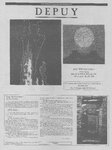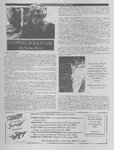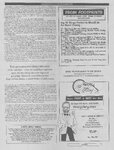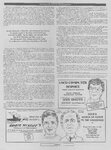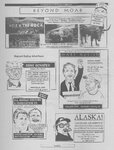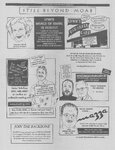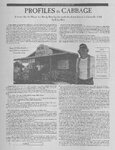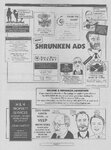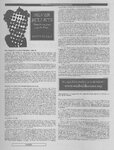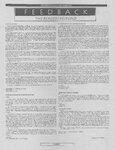| OCR Text |
Show DECEPTION Rainbow Bridge & DOUBLE-CROSS & the Restoration of Glen Canyon By Ken Sleight Bridge IF 1869, John Wesley Powell and his party boated down through Glen Canyon. Powell wrote glowingly of the canyon: “Past these towering monuments, past these mounded villows of orange sandstone, past these oak-set glens, past these fern-decked alcoves, past these mural curves, we glide hour after hour, stopping now and then as our attention is arrested by some new wonder.” Powell missed seeing the wonder of Rainbow Bridge, but stories of a legendary bridge of stone had cropped up for a number of years. John and Louisa Wetherill while operating their trading posts at Oljato and Kayenta listened intently to them.. Scholars Dr. Byron Cummings of the University of Utah and William B. Douglass of the General Land Office explored the great arch. Guided there by John Wetherill, the Ute Jim Mike and the Paiute Nasja Begay, the combined groups, after a long, tough, and scorching trip arrived there on Aug 14, 1909. So keyed up were they, that both Cummings and Douglas spurred their horses to be the first under the Bridge, but Wetherill beat them to it. Then on their return they reported to the outer world the magnificence and enchantment and geological meaning of Rainbow Bridge. So great the reports were that on May 30, 1910, President William Howard Taft proclaimed it a national monument and placed it in our nation’s special care to keep it from being damaged, desecrated or destroyed. So this set the stage for Rainbow’s future. Over the years came many threats and fears. In 1947, I was just starting college and tending to the family farm. I remember well the intense debates of how the flow of the Colorado River between the Upper Basin and Lower Basin states ought to be divided. In one of my classes. I would often argue against “The Compact” proposal. I just couldn’t understand the need for huge dams on major main-stream rivers. A nationwide storm of protest arose to the proposed Colorado River Storage Project passage then before Congress. Both Dinosaur and Rainbow Bridge National Monuments were in peril. The integrity of the National Park System was at risk. To achieve passage, the supporters of the dams agreed to the deletion of the Echo Park dam in the legislation while authorizing the Glen Canyon dam. However, in order to get the law passed, the proponents agreed that Rainbow Bridge National Monument would be assured protection. The following amendments were added: “That as part of the Glen Canyon Unit, the Secretary of the Interior shall take adequate protective measures to preclude impairment of Rainbow Bridge National Monument.” “It is the intention of Congress that no dam or reservoir constructed under the - authorization of this Act shall be within any national park or monument.” And with those assurances intact, the U.S. Congress passed it, and it was signed by the president on April 11, 1956. The Glen Canyon dam construction began that same year, in spite of the two provisions. I was taking trips to Glen Canyon and Rainbow Bridge in 1956 and so I was extremely interested in the varied proposals. I wasn’t happy with the law at all, but I took solace that Rainbow Bridge would be protected. It was a big fight. The advocates, appealing to their deity, envisioned the “deserts blooming as a rose” — transfiguring the canyons into the best of all possible worlds. Glen Canyon was meant to store water, else why the deep canyons? Rainbow Bridge had not yet been protected by March 1962, when David Brower restated our sentiments: “No park or monument will be safe from destruction if this betrayal of promises and flouting of the law is allowed to continue.” In order to comply with the law, The Bureau proposed the deceptive construction of “protective works.” A barrier dam would be built downstream from Rainbow Bridge to keep the waters of the reservoir out of the Monument. This meant the construction of many devastating roads and the further destructive gouging out of the canyon country. In December 1962, the National Parks Association (NPA) sought an injunction in the Washington D.C. district court. to prevent the closing of the diversion tunnels until the Rainbow Bridge argument was resolved. The court ruled against the NPA ruling that it had no standing to sue, but that the law’s provisions remained in force. In January 1963, the Bureau suddenly closed the gates of the west diversion tunnel. The reservoir soon rose to a depth of 34 feet. A forerunner of agonizing years ahead. Over the years, Congress passed a number of environmental laws, a sort of a “green revolution.” Among them, “To havea deep blue lake/Where no lake was before/Seems to bring man/A little closer Thisisa story about deception and double-cross the Wilderness Act in 1964, and the National Environmental Policy Act, (NEPA) in 1969. NEPA called for environmental studies and the preparation of an impact statement for federal related projects. Had these laws been in effect in the fifties and early sixties there assuredly would never have been a Glen Canyon dam. The completion of the Glen Canyon dam in 1963 saw the waters of the river quickly rise to bury and effectively destroy Music Temple, Hidden Passage, Gregory Natural Bridge, and the Cathedral in the Desert. It also forced enormous destructive changes upstream in Cataract Canyon and downstream in Grand Canyon. In 1965, the Bureau of Reclamation craftily promoted a new image - “Man and Nature in Peaceful Harmony ” in its horrid propaganda piece - Lake Powell, Jewel of the Colorado. Some quotes: “The manmade rock of the dam has become as one with the living rock of the canyon. It will endure as long as time endures.” to God.” “There is a natural order in our universe. serves God. But Nature serves Man.” - We were taken in, and taken in bad at Glen Canyon’s Rainbow Bridge. Rainbow Bridge is one of the most beautiful natural spectacles ever created. I would like to have been there at its birth, at the point in time when the stream flowed in a tight bend around a soft sandstone fin for its burst-through. Given that the earth is some 4.6 billion years old, its creation all happened in an infinitesimally small part of geologic time, a brief blink of an eye. Over the centuries Rainbow Bridge, now about 290 ft. high, grew magnificently while being sculpted in the two-hundred million years or so sandstone formation. The first humans to see Rainbow must have been stupefied with the sacred wonders of that entire region. Indian tribes of the area, both prehistoric and historic, certainly gathered there to worship and celebrate. Early settlements were made nearby at the foot of the Navajo Mountain. And later too, surely, cowboys and prospectors wandered onto Rainbow God created both Man and Nature. And Man : Floyd E. Dominy, the Commissioner of the Bureau of Reclamation in his moment of presumed solemnity in describing the reservoir, wrote lovingly and tenderly: “You have a front-row seat in an amphitheater of infinity. The bright blue sky deepens slowly to a velvet purple and the stars are brilliant — glittering in that vast immensity above. Orange sandstone cliffs fade to dusky red — then to blackest black. The fire burns low reflected in the placid lake. There is peace. And a oneness with the world and God.” After calling on God’s oneness and goodness, the pompous and unrepentant Dominy soon after, lobbied Congress to construct proposed dams downstream in our hallowed Grand Canyon — the Marble Canyon and the Bridge Canyon dams. “These dams are cash registers.” After the closing of the gates at the Glen Canyon dam, I continued taking river trips down the’ Colorado River through Cataract Canyon and Grand Canyon, led hiking and horse pack trips into Escalante Canyon and continued operating and renewing my permits in Glen Canyon in spite of the reservoir and the opposition. And during this time, the reservoir rose much higher, < ? and in 1970 it encroached into Rainbow Bridge National rs and unrepentant Floyd Dominy soon after lobbied Congress to construct proposed dams downstream in our hallowed Grand Canyon--- the Marble and Bridge Canyon Dams. "These dams are our cash cows.” Monument, exceeding the 3600-feet level. The provisions of the law meant little to the Bureau of Reclamation and its supporters. David Brower, the gutsy new president and founder of the Friends of the Earth continued the battle.. He litigated. Eagerly I joined him and the Friends of the Earth and Utah’s Wasatch Mountain Club as a river outfitter to help gain standing to sue. Our excellent attorneys filed suit in the District Court of Utah in November 1970 against the Commissioner of the Bureau of Reclamation and the Secretary of the Interior. We claimed that they were still required to prevent impairment of the Monument from the encroaching reservoir waters. However, they ignored the provisions of the law. . Then on Feb 27, 1973, my hero, the most honorable and most worthy Chief Judge Willis W. Ritter granted summary judgment in our favor. His judicial order reads in part: “That Rogers C. B. Morton, the Secretary of the Interior, and Ellis L. Armstrong, the Commissioner of the Bureau of Reclamation . . . are directed to take forthwith whatever actions are necessary to remove from within the boundaries of the Rainbow Bridge National Monument any waters of Lake Powell and the Glen Canyon unit impounded there . . and they, and each of them, are permanently enjoined and restrained from permitting or allowing the waters of Lake Powell and the Glen Canyon unit to enter or remain within the boundaries of the Rainbow Bridge National Monument.” David Brower and the environmental groups were ecstatic and jubilant.. And down in the canyons, I celebrated and eagerly awaited the removal of the waters. The judgment meant that the reservoir’s maximum elevation would need be lowered permanently. And “Ritter’s River” soon thundered through the dam. Senator Frank Moss of Utah swiftly introduced legislation in Congress on Feb 28, 1973 that would bypass or subvert Ritter’s decision. It would strike out the provision of the 1956 law that read “It is the intention of Congress that no dam or reservoir constructed under the authorization of this Act shall be within any national park or monument.” On March 14,1973, the government rapidly appealed Ritter’s decision to the U.S. Circuit Court of Appeals in Denver and the court reversed Judge Ritter’s decision. The morality and ethics of it all went down the tube. It was a classic case of power and money, Rainbow Bridge had not yet been protected And the betrayal and flouting persisted. I believe that certain government officials had never meant to protect Rainbow Bridge in the first place. Evidence shows that it was all a big deception and a double-cross.. PAGEI18 a |




